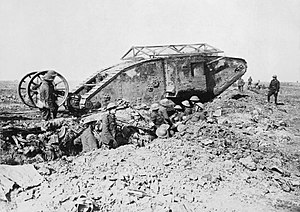British heavy tanks of World War I
| British heavy tanks of WWI | |
|---|---|

A British Mark I "male" tank near Thiepval on 25 September 1916, fitted with wire mesh to deflect grenades and the initial steering tail, shown raised
|
|
| Type | Tank |
| Place of origin | United Kingdom |
| Service history | |
| In service | (Mk I) from 1916 |
| Used by |
|
| Wars |
First World War Russian Civil War German Revolution of 1918–19 |
| Production history | |
| Designer | William Tritton, Major Walter Gordon Wilson |
| Designed | 1915 |
| Manufacturer | (Mk I) William Foster & Co. of Lincoln Metropolitan Carriage, Birmingham |
| Produced | (Mk I) 1916 |
| No. built | 150 |
| Variants | Mark II, Mark III, Mark IV, Mark V, Mark V*, Mark V**, Mark VI, Mark VII, Mark VIII, Mark IX, Mark X, Gun Carrier Mark I |
| Specifications (Tank, Mark I) | |
| Weight | Male: 28 long tons (28 t) Female: 27 long tons (27 t) |
| Length | 32 ft 6 in (9.91 m) with tail 25 ft 5 in (7.75 m) without |
| Width | 13 ft 9 in (4.19 m) [male] 14 ft 4 1⁄2 in (4.38 m) [female] |
| Height | 8 ft 2 in (2.49 m) |
| Crew | 8 (commander/brakesman, driver, two gearsmen and four gunners) |
|
|
|
| Armour | 0.24–0.47 in (6–12 mm) |
|
Main
armament |
Male: Two Hotchkiss 6 pdr QF Female: Four .303 in Vickers machine guns |
|
Secondary
armament |
Male: Three .303 in Hotchkiss Machine Guns Female: One .303 in Hotchkiss machine guns |
| Engine |
Daimler-Knight 6-cylinder sleeve-valve 16-litre petrol engine 105 horsepower (78 kW) |
| Power/weight | Male: 3.7 hp/LT (2.7 kW/t) Female: 4.0 hp/LT (2.9 kW/t) |
| Transmission | primary gearbox: 2 forward and 1 reverse secondary:2 speeds |
| Suspension | 26 unsprung rollers |
| Fuel capacity | 50 imperial gallons (230 l; 60 US gal) internal |
|
Operational
range |
23.6 miles (38.0 km) radius of action, 6.2 hours endurance |
| Speed | 3.7 mph (6.0 km/h) maximum |
British heavy tanks were a series of related armoured fighting vehicles developed by the UK during the First World War.
The Mark I was the world's first tank, tracked and armed armoured vehicle, to enter combat. The name "tank" was initially a code name to maintain secrecy and disguise its true purpose. The type was developed in 1915 to break the stalemate of trench warfare. It could survive the machine gun and small-arms fire in "No Man's Land", travel over difficult terrain, crush barbed wire, and cross trenches to assault fortified enemy positions with powerful armament. Tanks also carried supplies and troops.
British heavy tanks are distinctive, with an unusual rhomboidal shape with a high climbing face of the track, designed to cross the wide and deep trenches prevalent on the battlefields of the Western Front. Due to the height necessary for this shape, an armed turret would have made the vehicle too tall and unstable. Instead, the main armament was arranged in sponsons at the side of the vehicle. The prototype, named "Mother", mounted a 6-pounder (57 mm) cannon and a Hotchkiss machine gun at each side. Later, subtypes were produced with machine guns only, which were designated "Female", while the original version with the protruding 6-pounder was called "Male".
The Mark I entered service in August 1916, and was first used in action on the morning of 15 September 1916 during the Battle of Flers-Courcelette, part of the Somme Offensive. With the exception of the few interim Mark II and Mark III tanks, it was followed by the largely similar Mark IV, which first saw combat in June 1917. The Mark IV was used en masse, about 460 tanks, at the Battle of Cambrai in November 1917. The Mark V, with a much improved transmission, entered service in mid-1918. More than two thousand British heavy tanks were produced. Manufacture was discontinued at the end of the war.
...
Wikipedia
